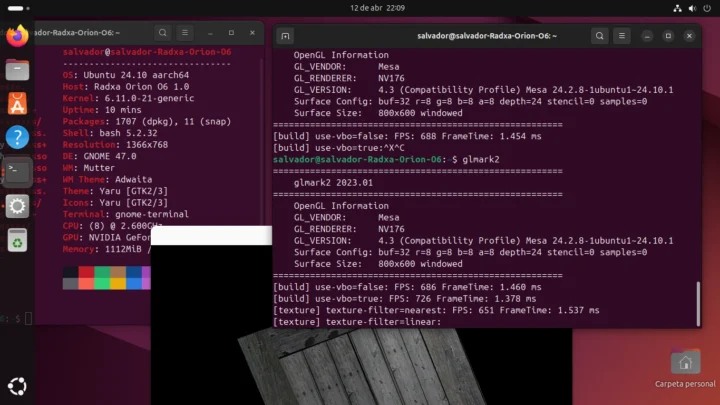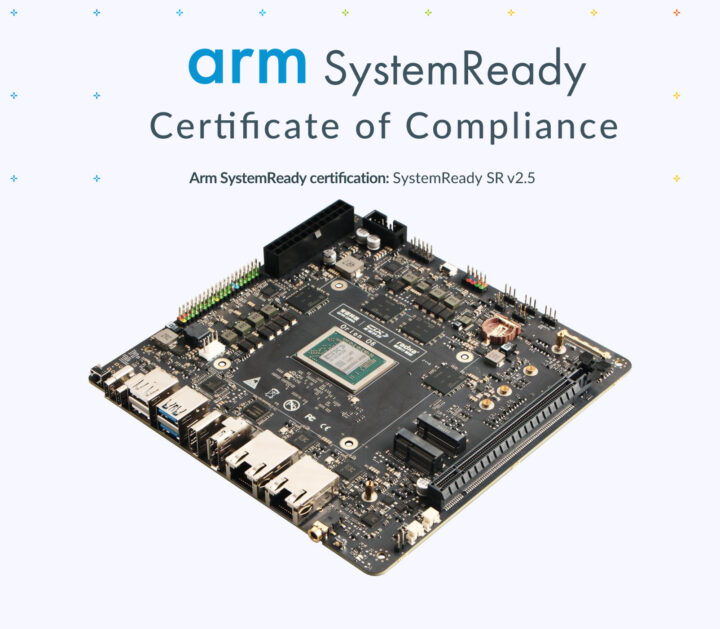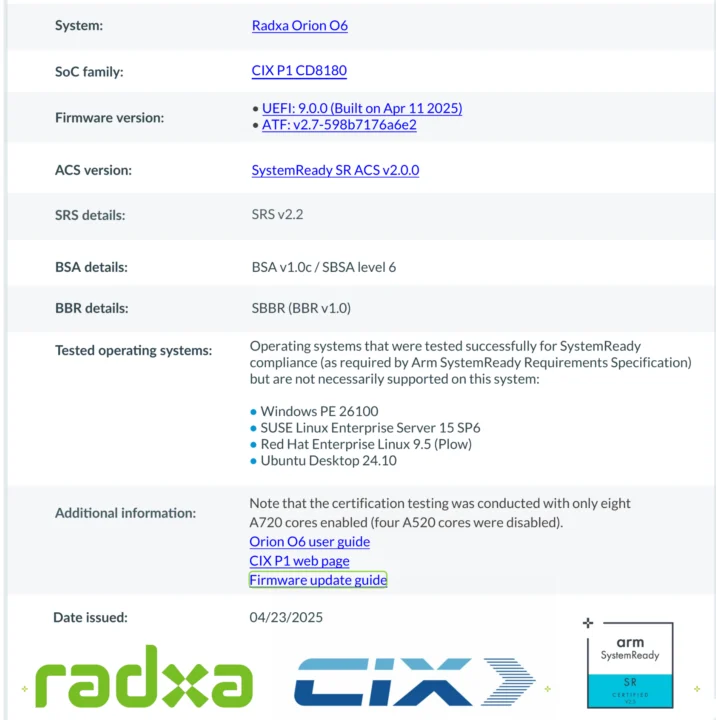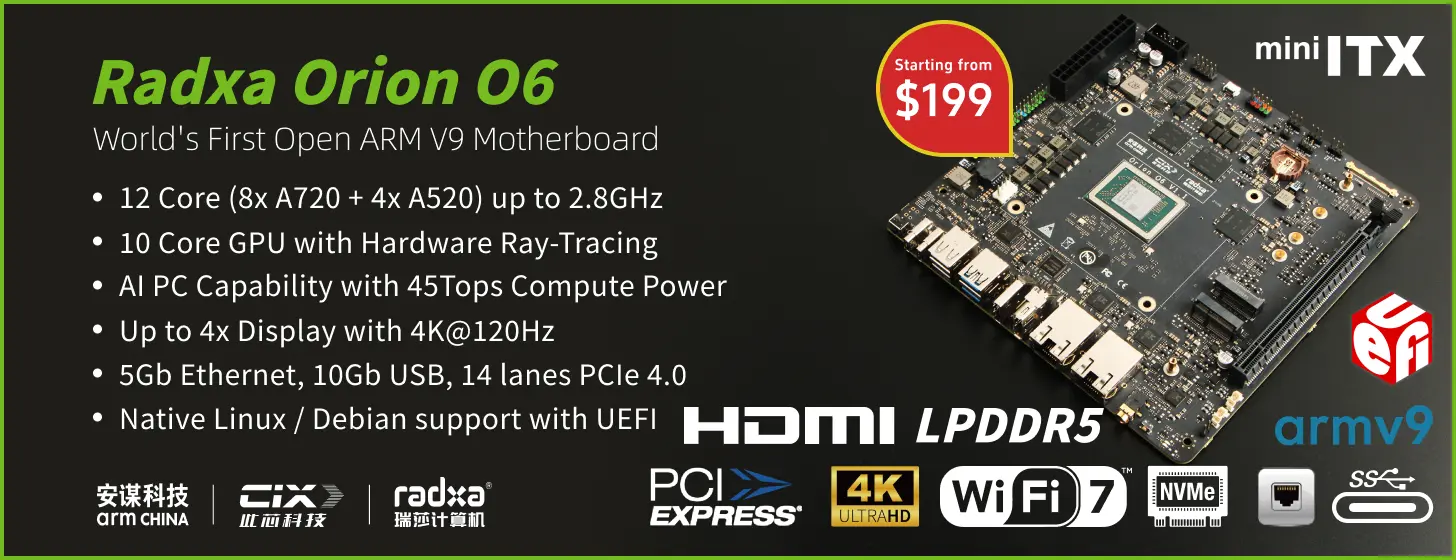Radxa Orion O6 mini-ITX motherboard powered by a CIX P1 12-core Cortex-A720/A520 SoC has just obtained Arm SystemReady SR (ServerReady) v2.5 certification, meaning it’s been shown to run unmodified several OS images such as Windows and Ubuntu.
I’ve already tested a Debian 12 image modified by Radxa on the Orion O6, but one of the goals of the platform was to provide a universal UEFI + ACPI firmware to boot any Arm ISO released by OS vendors, for instance, the Ubuntu Desktop ISO for Arm 64-bit architecture downloaded directly from the Ubuntu website. The Arm SystemReady SR certification is a step in the right direction, as it means the Orion O6 has passed a number of tests showing it can boot several off-the-shelf OS images.
We’ll find Radxa’s Orion O6 listed on the Arm SystemReady Compliance page among boards from other manufacturers, as well as the Radxa ROCK Pi 4B+, which got SystemReady IR certified in 2022.
The Radxa Orion O6 used UEFI 9.0.0 (Built on Apr 11 2025) and ATF v2.7-598b7176a6e2 firmware for testing (See download link and installation instructions), and four operating systems were successfully tested for SystemReady
compliance, but are not necessarily supported on this system (more on that later):
- Windows PE 26100 – A lightweight, stripped-down version of Windows 11 24H2 designed for deploying, troubleshooting, or recovering Windows operating systems
- SUSE Linux Enterprise Server 15 SP6
- Red Hat Enterprise Linux 9.5 (Plow)
- Ubuntu Desktop 24.10
For some reason, only the eight Cortex-A720 cores were enabled during testing, and the four Cortex-A520 cores were disabled.
Some parts of the certificate may need some explanations:
- ACS Version: SystemReady SR ACS v2.0.0 refers to the Architecture Compliance Suite to verify compliance with SRS v2.2 with BSA v1.0c, SBSA Level 6, and SBBR (BBR v1.0) mentioned below.
- SRS Detail: SRS v2.2 (SystemReady Requirements Specification) is a document that outlines the requirements for achieving SystemReady certification. For instance, the system must be able to boot and be installed from a range of media, and the user should have access to the console with networking enabled.
- BSA Details: BSA v1.0c (Base System Architecture) and SBSA Level 6 (Server Base System Architecture) define hardware requirements, for example, related to the PCIe interface(s)
- BBR Details: SBBR (BBR v1.0) standardizes server firmware (UEFI + ACPI). SBBR stands for Server Base Boot Requirements.
You can check a few repositories on the ARM-Software GitHub account to learn more about Arm SystemReady compliance.
Arm SystemReady certification means the Orion O6 passed several tests confirming the motherboard can run and install unmodified operating systems, the user can access the console, networking is working, etc…. But it does not mean everything magically works out of the box, and there will still be a few issues, notably with drivers that need tweaking…
For instance, a few users have already tested the V9.0.0 firmware with ACPI enabled by default, and they could install Windows 11, Ubuntu 24.10, and Fedora rawhide without major issues. However, while several graphics cards can be recognized and work to some extent, there are still some performance issues and quirks. We also know why the LITTLE Cortex-A520 cores have been disabled. If they are enabled in the BIOS, Windows 11/WinPE won’t boot properly, and instead show a BSOD. They should work fine in Linux.


Jean-Luc started CNX Software in 2010 as a part-time endeavor, before quitting his job as a software engineering manager, and starting to write daily news, and reviews full time later in 2011.
Support CNX Software! Donate via cryptocurrencies, become a Patron on Patreon, or purchase goods on Amazon or Aliexpress. We also use affiliate links in articles to earn commissions if you make a purchase after clicking on those links.






